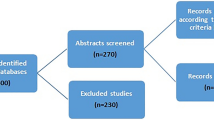Abstract
A case-control study of 156 cases of various types of benign breast disease (BBD) and 156 population controls was conducted to investigate the role of various behavioral, reproductive, and hormonal factors in the etiology of these breast disorders. Our results indicate that the distinct histological groups of BBD differ from each other in respect to possible risk factors. Small sample size poses severe restrictions on the conclusiveness of the results and thus they should be considered as preliminary and suggestive. Our results do not support the notion that BBD could be considered as a uniform entity with common risk factors.
Similar content being viewed by others
Abbreviations
- BBD:
-
benign breast disease
- BC:
-
breast cancer
- OR:
-
oral contraceptive
References
Hutchinson WB, Thomas DB, Hamlin WB, Roth GJ, Peterson AV, Williams B. Risk of breast cancer in women with benign breast disease. J Natl Cancer Inst 1980; 65: 13–20.
Carter CL, Corle DK, Micozzi MS, Schatzkin A, Taylor PR. A prospective study of the development of breast cancer in 16,692 women with benign breast disease. Am J Epidemiol 1988; 128: 467–477.
McDivitt RW, Stevens JA, Lee NC, et al. Histologic types of benign breast disease and the risk for breast cancer. Cancer 1992; 69: 1408–1414.
London SJ, Connolly JL, Schnitt SJ, Colditz GA. A prospective study of benign breast disease and the risk of breast cancer. JAMA 1992; 267: 941–944.
Lees AW, Burns PE, Grace M. Oral contraceptives and breast disease in premenopausal Northern Albertan women. Int J Cancer 1978; 22: 700–707.
Kelsey JL, Holford TR, White C, Mayer ES, Kilty SE, Acheson RM. Oral contraceptives and breast disease: An epidemiological study. Am J Epidemiol 1978; 107: 236–244.
Ma L, Boyd NF. Atypical hyperplasia and breast cancer risk: A critique. Cancer Causes and Control 1992; 3: 517–525.
Rautalahti M, Albanes D, Virtamo J, Palmgren J, Haukka J, Heinonen OP. Lifetime menstrual activity — indicator of breast cancer risk. Eur J Epidemiol 1993; 9: 17–25.
Breslow NE, Day NE. Statistical methods in cancer research. Lyon: Scientific publication IARC, 1980.
Cole P, Elwood JM, Kaplan SD. Incidence rates and risk factors of benign breast neoplasms. Am J Epidemiol 1978; 108: 112–120.
Brinton LA, Vessey MP, Flavel R, Yeates D. Risk factors for benign breast disease. Am J Epidemiol 1981; 113: 203–214.
Soini I, Aine R, Lauslahti K, Hakama M. Independent risk factors of benign and malignant breast lesions. Am J Epidemiol 1981; 114: 507–514.
Fleming NT, Armstrong BK, Sheiner HJ. The comparative epidemiology of benign breast lumps and breast cancer in western Australia. Int J Cancer 1982; 30: 147–152.
Wang DY, Fentiman IS. Epidemiology and endocrinology of benign breast disease. Breast Cancer Res Treat 1985; 6: 5–36.
Mitchell GW. Benign breast disease and cancer. Clin Obstet Gynecol 1986; 29: 705–714.
Sismondi P, Giai M, Defabiani E, Biglia N. Benign breast disease: An update. In: Onnis A, ed. Clinical and experimental obstetrics and gynecology. Padova, Italy: Clin Exp Obstet Gynecol, 1990: 56–116.
Nomura A, Comstock GW, Tonascia JA. Epidemiologic characteristics of benign breast disease. Am J Epidemiol 1977; 105: 505–512.
Sartwell PE, Arthes FG, Tonascia JA. Benign and malignant breast tumours: Epidemiological similarities. Int J Epidemiol 1978; 7: 217–221.
Berkowitz GS, Kelsey JL, LiVolsi VA, et al. Risk factors for fibrocystic breast disease and its histopathologic components. J Natl Cancer Inst 1985; 75: 43–50.
Pastides H, Kelsey JL, Holford TR, LiVolsi VA. An epidemiologic study of fibrocystic breast disease with reference to ductal epithelial atypia. Am J Epidemiol 1985; 121: 440–447.
Odenheimer DJ, Zunzunegui MV, King MC, Shipler CP, Friedman GD. Risk factors for benign breast disease: A case-control study of discordant twins. Am J Epidemiol 1984; 120: 565–571.
La Vecchia C, Parazzini F, Franceschi S, Decarli A. Risk factors for benign breast disease and their relation with breast cancer risk: Pooled information from epidemiologic studies. Tumori 1985; 71: 167–178.
Parazzini F, La Vecchia C, Franceschi S, et al. Risk factors for pathologically confirmed benign breast disease. Am J Epidemiol 1984; 120: 115–122.
Olsson H, Landin-Olsson M, Gullberg B. Retrospective assessment of menstrual cycle length in patients with breast cancer, in patients with benign breast disease, and in women without breast disease. J Natl Cancer Inst 1983; 70: 17–20.
Hislop TG, Elwood JM. Risk factors for benign breast disease: a 30-year cohort study. CMA Journal 1981; 124: 283–291.
Peters F, Schuth W. Hyperprolactinemia and non-puerperal mastitis (duct ectasia). JAMA 1989; 261: 1618–1620.
Brown RW, Meehan C, Martin FIR, Bhathal PS. Breast tumors in patients with hyperprolactinemia. Cancer 1982; 50: 125–129.
Albanes D, Winick M. Are cell number and cell proliferation risk factors for cancer. J Natl Cancer Inst 1988; 80: 772–775.
Frantz VK, Pickren JW, Melcher GW, Auchincloss H Jr. Incidence of chronic cystic disease in socalled 'normal breasts'. Cancer 1951; 4: 762–783.
Humphrey LJ, Swerdlow M. Histologic changes in clinically normal breasts at postmortem examination. Arch Surg 1966; 92: 192–193.
Bhathal PS, Brown RW, Lesueur GC, Russell IS. Frequency of benign and malignant breast lesions in 207 consecutive autopsies in Australian women. Br J Cancer 1985; 51: 271–278.
Fasal E, Paffenbarger RS. Oral contraceptives as related to cancer and benign lesions of the breast. J Natl Cancer Inst 1975; 55: 767–773.
Hislop TG, Threlfall WJ. Oral contraceptives and benign breast disease. Am J Epidemiol 1984; 120: 273–280.
Janerich DT, Glebatis DM, Dugan JM. Benign breast disease and oral contraceptive use. JAMA 1977; 237: 2199–2201.
LiVolsi VA, Stadel BV, Kelsey JL, Holford TR, White C. Fibrocystic breast disease in oral-contraceptive users: A histopathological evaluation of epithelial atypia. N Eng1 J Med 1978; 299: 381–385.
Dupont WD, Page DL. Risk factors for breast cancer in women with proliferative breast disease. N Engl J Med 1985; 312: 146–151.
Author information
Authors and Affiliations
Rights and permissions
About this article
Cite this article
Rautalahti, M., Albanes, D., Haukka, J. et al. Risk factors for histologically confirmed benign breast tumors. Eur J Epidemiol 10, 259–265 (1994). https://doi.org/10.1007/BF01719347
Accepted:
Issue Date:
DOI: https://doi.org/10.1007/BF01719347




